Holding firmly onto the ship’s handrail I extend a tentative rubber booted foot towards the rigid inflatable boat gently bobbing on the water below. Heeding the advice of the previous evening’s introductory talk I’m dressed “like an onion”, and in so many layers I bear more than a passing resemblance to the Michelin tyre man.
I’m certainly not kitted out to do any dainty dance steps but that’s the advice being issued by expedition leader Cristobal Villanueva. “Remember to do the cha cha cha as you get on the RIB,” he says. “Step on the step, step on the boat and then step inside.” Three easy moves later and I’m sitting next to a small group of fellow passengers and we head out across Admiralty Sound, an offshoot of the Strait of Magellan.
It was just over 500 years ago that Portuguese explorer Ferdinand Magellan discovered his namesake strait while leading the first expedition to successfully circumnavigate the globe.
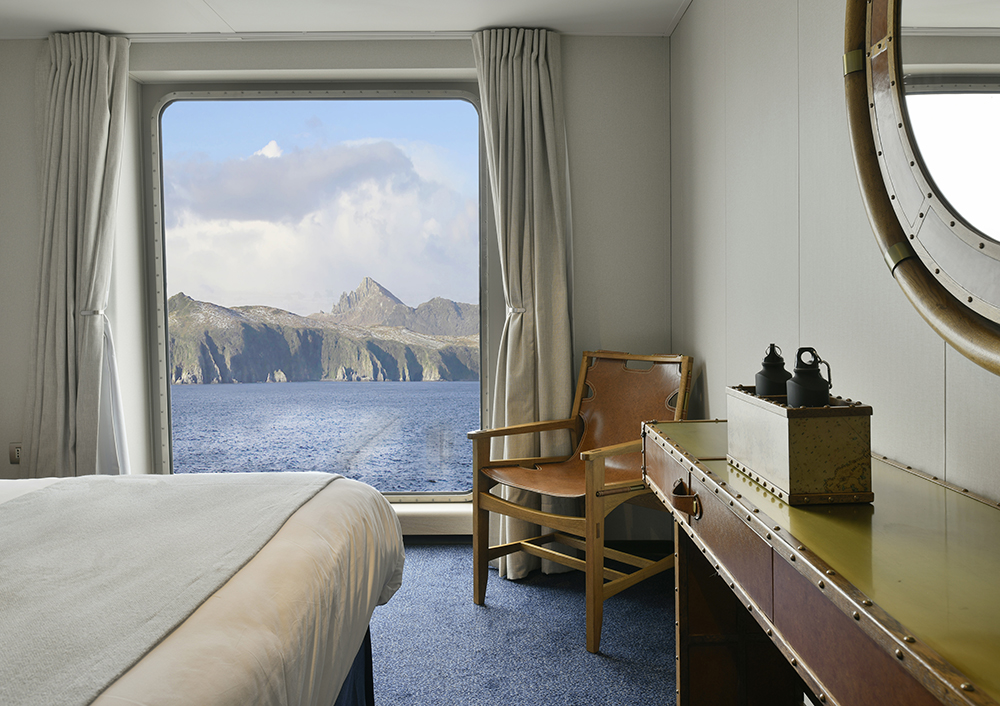
It’s a natural passageway between the Atlantic and Pacific Ocean but at one time the corridor of icy cliffs stretching across Patagonia was seemingly impenetrable and impossible to navigate.
Today it still remains one of the most isolated spots on earth and Australis is the only expedition cruise company to navigate the narrow fjords and shallow bays in the wake of Magellan and his pioneering men.
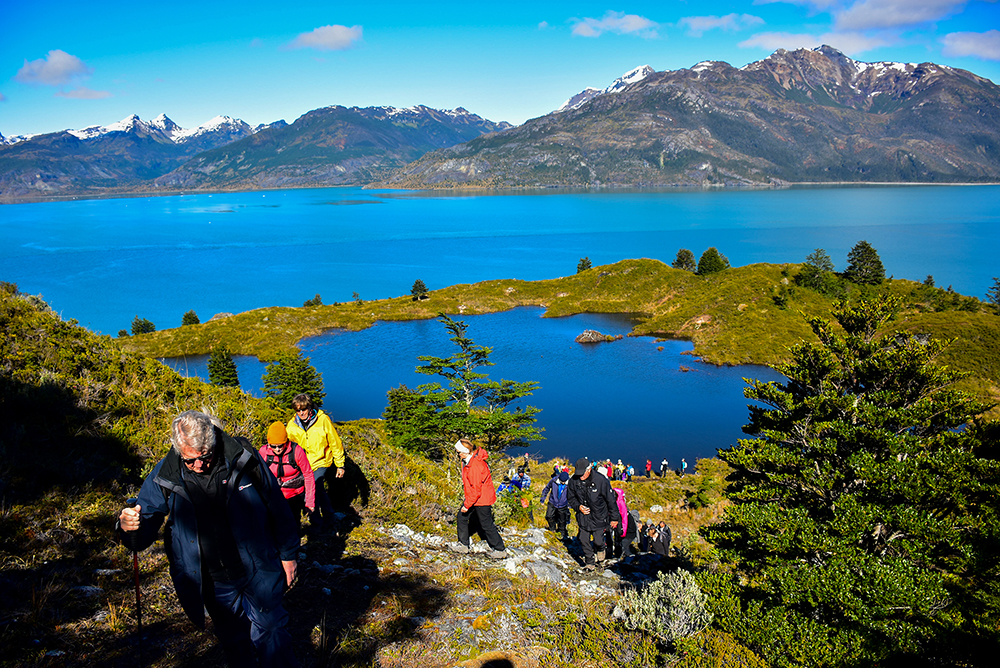
Alighting from the RIB at Ainsworth Bay is much easier. Crew members have put down a gangplank and I step out onto springy wet grass. We set off on a nature hike and I begin to shed the onion-skin as I warm up, making a mental note not to wear so much the next day. We follow our guide into a sub-polar forest, stopping along the way as he spots calafate bushes huddling under trees and shrubs. The purple berries guarded by sharp thorns punctuate the verdant surroundings like small jewels and we stoop to taste them. They’re like blueberries – only better.
Deep in the woodland we pause at a crystal–clear waterfall tumbling down an emerald moss-covered rock face. Nearby is a small tree with an incongruous yellow tag and I wonder how on earth it got there.
All becomes clear when we’re told that in 2013 the Chilean scientific organisation El Centro de Estudios del Cuaternario, Fuego-Patagonia y Antártica (CEQO) launched a unique and subsequently award-winning conservation initiative in partnership with Australis to monitor the marine environment. Our guide says we’ll hear more about it in the ensuing days.
For now it’s time to head back to the 200-passenger Ventus Australis for lunch which, with sister ship Stella Australis, sails four and eight-night itineraries from September to April – from Punta Arenas in Chile to Ushuaia in Argentina, or reverse – around the Patagonian fjords and islands of the Terra del Fuego archipelago. These isles span almost 29,000 square miles with around two thirds governed by Chile and the rest by Argentina. Along with the Strait of Magellan, the network of connecting bodies of water include other evocative and fabled names such as the Beagle Channel and Drake Passage.
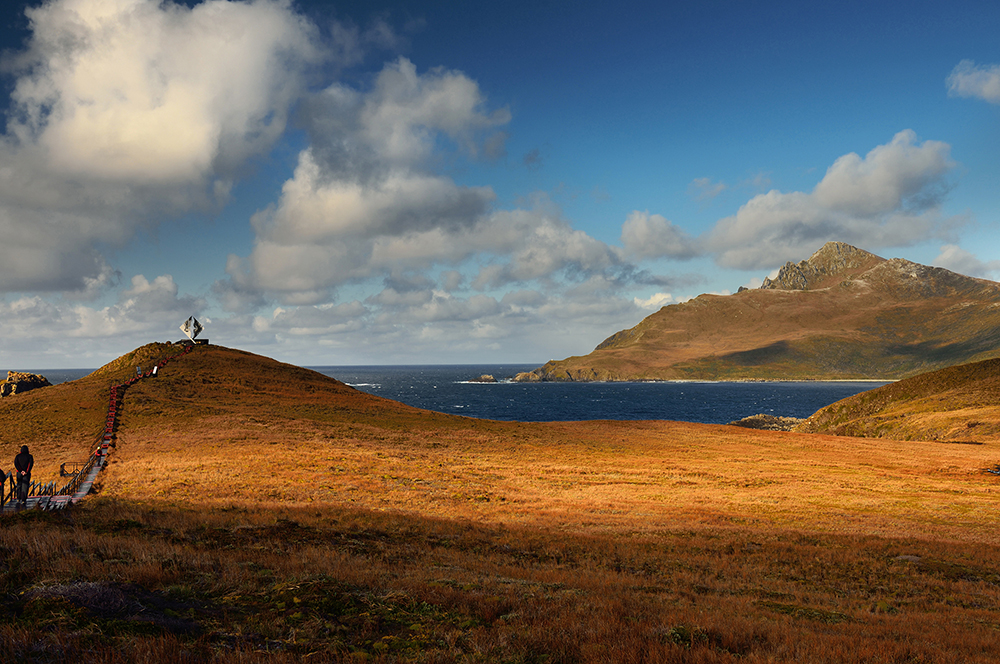
Along with the Strait of Magellan, the network of connecting bodies of water include other evocative and fabled names such as the Beagle Channel and Drake Passage.
I’ve been assigned a dining table with fellow Brits and a Canadian couple. Wine and drinks are all included in the fare so it’s no surprise the onboard atmosphere is very convivial as we get to know each other.
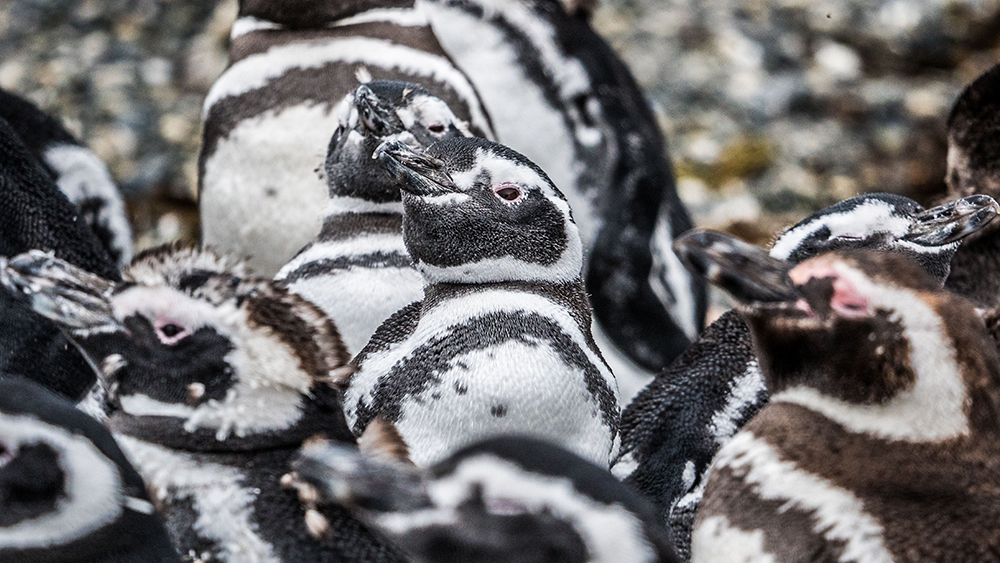
That afternoon we cha cha cha back onto the RIBs and sail west along the sound to the cluster of small islands that make up Tucker Islets. More than 4,000 Magellanic penguins nest, hatch and nurture their chicks here and our helmsman steers the RIB close to the shore.
I delight at the spectacle of the large colony languishing on the shoreline, oblivious to our presence, and the unusual sight of them waddling off into long grass. The adults stand out with their distinctive monochrome uniform of a thick black ‘necklace’ and pair of black bands running across their creamy bellies. One is even more noticeable as it is completely white, a rare genetic quirk.
Larger chicks stand longingly at the water’s edge, getting ready to moult their ugly duckling plumage in order to take the plunge for the first time. Until that happens they remain beach bound.
We watch spellbound for an hour before the RIB darts between some of the other islets. Patagonia is a paradise for birdwatchers and we get close-up views of ground-nesting imperial cormorants guarding their eggs from predators on bare rocks and the cinnamon flash of Chilean skuas soaring overhead. Then, most breath-taking of all, the hunched outline of an Andean condor. The largest bird in Patagonia, it cuts a figure that’s both menacing and majestic as it stands on a crag scanning the rocky nursery for any eggs left unattended. Eventually it gives up and, with a few slow–motion flaps of a 10ft wingspan, its huge bulk takes off to seek new feeding grounds. On the way back to Ventus Australis dolphins follow the RIBs and dive playfully in the wash. There’s certainly plenty to talk about over dinner.
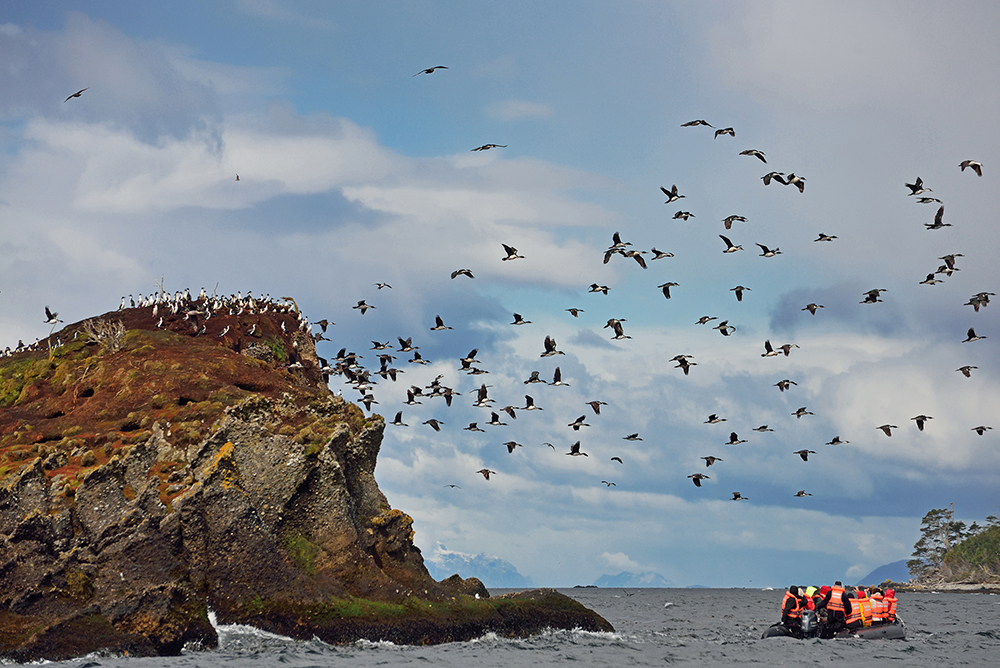
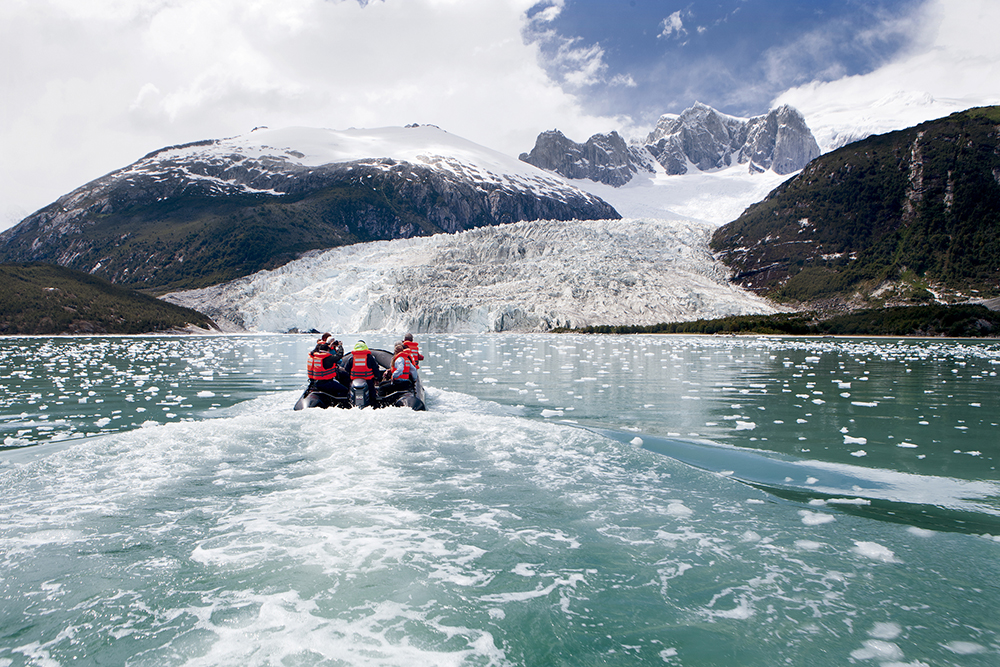
Next morning, we arrive in Pia Fjord and after lunch disembark to visit the glacier of the same name, which is the largest and most active in Patagonia. Set against snowy mountains gleaming icy blue in the cloudless sky it’s incredible to see. Even more so when a loud creaking followed by a thunderous crack breaks our awe-struck silence. Known as calving, a piece of ice, nearly 100ft high, breaks away from the glacier and pierces the motionless water below, triggering waves carrying shards of shattered ice that make the RIBs pitch and roll in the maelstrom.
Nearly 90% of Chile’s glaciers are located here and the following day we listen to one of many insightful lectures before sailing deeper into ‘glacier alley’.
“Glaciers are like people, they may look the same but they are all very different,” says Cristobal as he explains how the ship’s guides act as the eyes and ears of scientists and collect data used in studies and reports.
“There is a fixed camera at Pia Glacier which takes a photo four times a day at the same time and this is sent to the scientific programme to monitor the advancing or retreating of the glacier.
“Scientists don’t have the opportunity to come here very often as it is very expensive to do so, but we are here all the time during the season so we record data. It also provides us with the most accurate and up to date information to give to our guests. The crew on the first Zodiac of the day, which takes the gangplank to the places we land, carry out survey in a set area of land at each place and take water samples. They record flora, fauna and the birds that they see. For example, in one area there’s a resident seagull colony where we count the number of adults, juveniles and chicks. It requires binoculars and patience!”
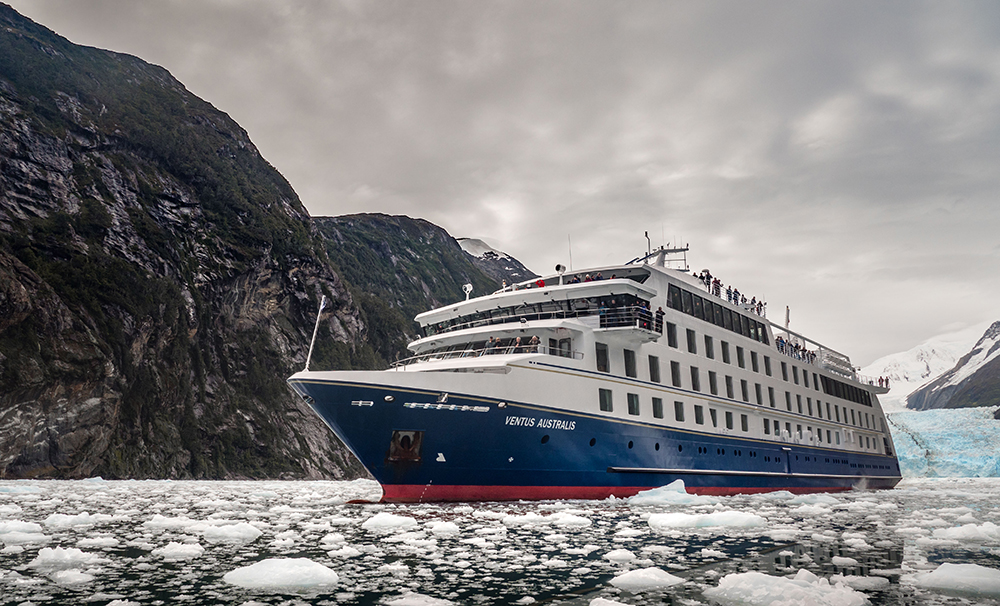
Australis offers four- and eight-night cruises between Ushuaia in Argentina and Punta Arenas in Chile, exploring the isolated fjords and islands of Tierra del Fuego in southernmost Patagonia. Just ask us by email for more information on this and other expedition cruises.
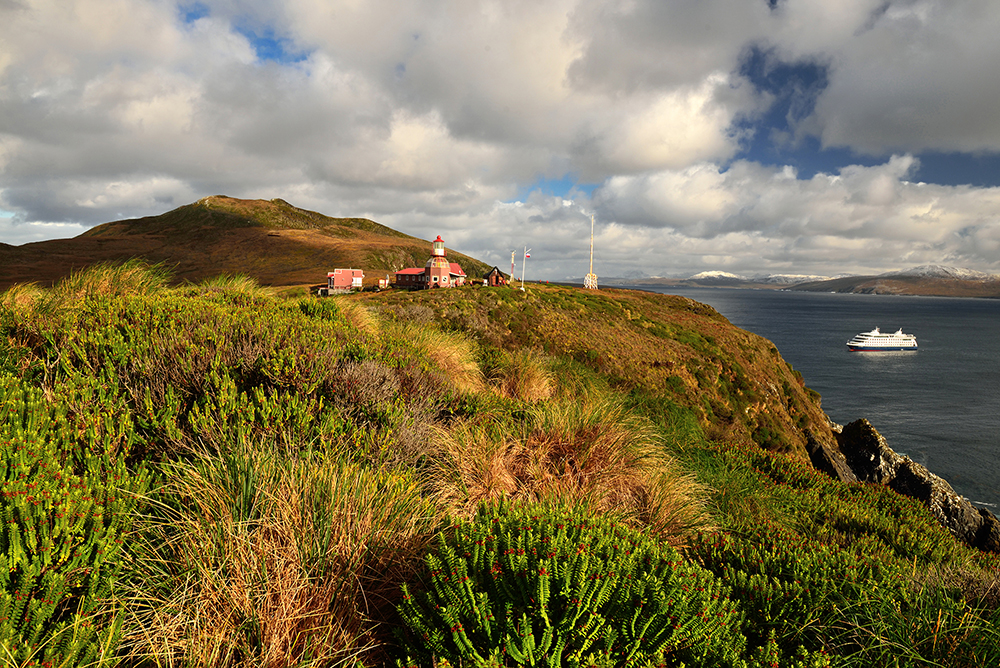
Overnight we sail towards Nassau Bay, reaching legendary Cape Horn at dawn. There’s a palpable excitement at breakfast as the ship can only land passengers on the notoriously windswept island if weather and sea conditions permit. We’re lucky and scale the steps leading to the 1,394-foot-high promontory overlooking the tempestuous waters of the Drake Passage. At one time it was the only navigation route between the Pacific and Atlantic, and referred to as the ‘End of the Earth.
That night I sip a refreshing fanshop, a favourite Chilean tipple that’s a mix of beer and orange soda, and swap tales of the day with fellow shipmates. We’ve bonded over an extraordinary voyage that lives, breathes and – through the scientific programme – monitors the wild untamed beauty of Patagonia.
Here are some other remarkable remote destinations which can be explored via an expedition cruise…
The Arctic
Spitsbergen, the only permanently populated island in Norway’s Svalbard archipelago is one of the world’s northernmost inhabited areas. During the summer it is the gateway to Arctic sailings to spot polar bears and dramatic scenery.
The Galapagos
This volcanic archipelago off the Ecuadorian coast is the ultimate bucket list trip for wildlife lovers, with 27 species found only in the Galapagos. Visited by naturalist Charles Darwin in1835, his research led to the ground-breaking theory of evolution.
Antarctica
South America’s southernmost tip leads to the most isolated continent on the globe. The frozen landscape is explored on daily Zodiac excursions or, for the energetic, paddling through the glacial waters on kayaks. Combine a cruise with a stay in the buzzing Argentinian capital of Buenos Aires.
The Amazon
South America’s largest river flows for 4,345 miles and more than 60% of Peruvian territory is covered by the Amazon rainforest. The mighty river can be explored on river cruises from Iquitos, a two-hour flight from Lima, or on Brazilian seas cruises sailing to Manaus, the river’s furthest navigable port 1,000 miles inland.
This is a feature from Issue 4 of Charitable Traveller. Click to read more from this issue.



Fundraising Futures Community Interest Company, Contingent Works, Broadway Buildings,
Elmfield Road, Bromley, Kent,
BR1 1LW. England
Putting our profit to work supporting the work of charitable causes











For the latest travel advice, including security, local laws and passports, visit the Foreign & Commonwealth Office website.
© 2024 All rights reserved
Made with 
| Cookie | Duration | Description |
|---|---|---|
| AWSELB | session | Associated with Amazon Web Services and created by Elastic Load Balancing, AWSELB cookie is used to manage sticky sessions across production servers. |
| cookielawinfo-checkbox-advertisement | 1 year | Set by the GDPR Cookie Consent plugin, this cookie is used to record the user consent for the cookies in the "Advertisement" category . |
| cookielawinfo-checkbox-analytics | 11 months | This cookie is set by GDPR Cookie Consent plugin. The cookie is used to store the user consent for the cookies in the category "Analytics". |
| cookielawinfo-checkbox-functional | 11 months | The cookie is set by GDPR cookie consent to record the user consent for the cookies in the category "Functional". |
| cookielawinfo-checkbox-necessary | 11 months | This cookie is set by GDPR Cookie Consent plugin. The cookies is used to store the user consent for the cookies in the category "Necessary". |
| cookielawinfo-checkbox-others | 11 months | This cookie is set by GDPR Cookie Consent plugin. The cookie is used to store the user consent for the cookies in the category "Other. |
| cookielawinfo-checkbox-performance | 11 months | This cookie is set by GDPR Cookie Consent plugin. The cookie is used to store the user consent for the cookies in the category "Performance". |
| elementor | never | This cookie is used by the website's WordPress theme. It allows the website owner to implement or change the website's content in real-time. |
| JSESSIONID | session | Used by sites written in JSP. General purpose platform session cookies that are used to maintain users' state across page requests. |
| viewed_cookie_policy | 11 months | The cookie is set by the GDPR Cookie Consent plugin and is used to store whether or not user has consented to the use of cookies. It does not store any personal data. |
| Cookie | Duration | Description |
|---|---|---|
| __lc_cid | 2 years | This is an essential cookie for the website live chat box to function properly. |
| __lc_cst | 2 years | This cookie is used for the website live chat box to function properly. |
| __oauth_redirect_detector | past | This cookie is used to recognize the visitors using live chat at different times inorder to optimize the chat-box functionality. |
| aka_debug | session | Vimeo sets this cookie which is essential for the website to play video functionality. |
| player | 1 year | Vimeo uses this cookie to save the user's preferences when playing embedded videos from Vimeo. |
| Cookie | Duration | Description |
|---|---|---|
| AWSELBCORS | 6 minutes | This cookie is used by Elastic Load Balancing from Amazon Web Services to effectively balance load on the servers. |
| Cookie | Duration | Description |
|---|---|---|
| _ga | 2 years | The _ga cookie, installed by Google Analytics, calculates visitor, session and campaign data and also keeps track of site usage for the site's analytics report. The cookie stores information anonymously and assigns a randomly generated number to recognize unique visitors. |
| _gat_gtag_UA_164521185_1 | 1 minute | This cookie is set by Google and is used to distinguish users. |
| _gid | 1 day | Installed by Google Analytics, _gid cookie stores information on how visitors use a website, while also creating an analytics report of the website's performance. Some of the data that are collected include the number of visitors, their source, and the pages they visit anonymously. |
| _hjAbsoluteSessionInProgress | 30 minutes | No description available. |
| _hjFirstSeen | 30 minutes | This is set by Hotjar to identify a new user’s first session. It stores a true/false value, indicating whether this was the first time Hotjar saw this user. It is used by Recording filters to identify new user sessions. |
| _hjid | 1 year | This is a Hotjar cookie that is set when the customer first lands on a page using the Hotjar script. |
| _hjIncludedInPageviewSample | 2 minutes | No description available. |
| CONSENT | 16 years 3 months 16 days 17 hours 23 minutes | These cookies are set via embedded youtube-videos. They register anonymous statistical data on for example how many times the video is displayed and what settings are used for playback.No sensitive data is collected unless you log in to your google account, in that case your choices are linked with your account, for example if you click “like” on a video. |
| iutk | 5 months 27 days | This cookie is used by Issuu analytic system. The cookies is used to gather information regarding visitor activity on Issuu products. |
| vuid | 2 years | Vimeo installs this cookie to collect tracking information by setting a unique ID to embed videos to the website. |
| Cookie | Duration | Description |
|---|---|---|
| IDE | 1 year 24 days | Google DoubleClick IDE cookies are used to store information about how the user uses the website to present them with relevant ads and according to the user profile. |
| mc | 1 year 1 month | Quantserve sets the mc cookie to anonymously track user behaviour on the website. |
| NID | 6 months | NID cookie, set by Google, is used for advertising purposes; to limit the number of times the user sees an ad, to mute unwanted ads, and to measure the effectiveness of ads. |
| test_cookie | 15 minutes | The test_cookie is set by doubleclick.net and is used to determine if the user's browser supports cookies. |
| VISITOR_INFO1_LIVE | 5 months 27 days | A cookie set by YouTube to measure bandwidth that determines whether the user gets the new or old player interface. |
| YSC | session | YSC cookie is set by Youtube and is used to track the views of embedded videos on Youtube pages. |